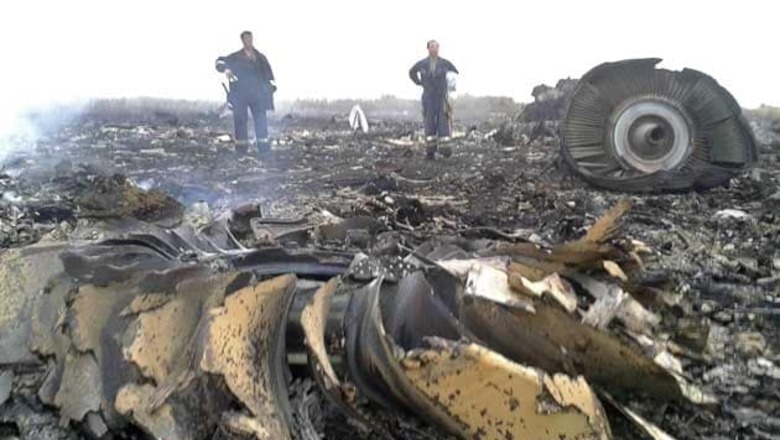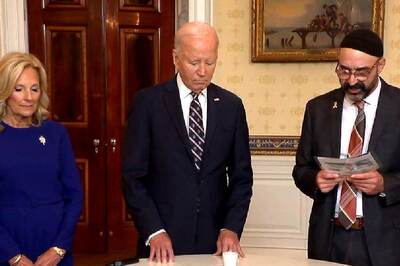
views
Kharviv (Ukraine): Two more military aircraft carrying remains of victims from the Malaysian plane disaster arrived in the Netherlands on Thursday, while Australian and Dutch diplomats joined to promote a plan for a UN team to secure the crash site which has been controlled by pro-Russian rebels.
Human remains continue to be found a full week after the plane went down, underlining concerns about the halting and chaotic recovery effort at the sprawling site spread across farmland in eastern Ukraine. Armed separatists control the area and have hindered access by investigators.
All 298 people aboard Malaysia Airlines Flight 17 - most of them Dutch citizens - were killed when the plane was shot down on July 17. U.S. officials say the Boeing 777 was probably shot down by a missile from territory held by pro-Russian rebels, likely by accident.
Australian Prime Minister Tony Abbott, who says he fears some remains will never be recovered unless security is tightened, has proposed a multinational force mounted by countries such as Australia, the Netherlands and Malaysia that lost citizens in the disaster. Abbott said Thursday he had dispatched 50 police officers to London to be ready to join any organization which may result.
Australia's Foreign Minister Julie Bishop was traveling with her Dutch counterpart Frans Timmermans to Kiev to seek an agreement with the Ukraine government to allow international police to secure the wreckage, Abbott said.
Details including which countries would contribute and whether officers would be armed and protected by international troops were yet to be agreed, Abbott said.
Meanwhile, global aviation leaders will meet in Montreal next week to initiate discussions on a plan to address safety and security issues raised by the shooting down of the jet, an aviation official said late Thursday. The official spoke on condition of anonymity because he wasn't authorized to discuss the issue publicly by name.
International experts found more remains still at the crash site both Wednesday and Thursday, Michael Bociurkiw, a spokesman for the Organization for Security and Cooperation in Europe, told reporters in Donetsk on Thursday. OSCE observers, sent to monitor the conflict, escorted a delegation from Australia to examine the wreckage Thursday for the first time. More Australian specialists are expected to join them Friday, Bociurkiw said.
On Monday, the U.N. Security Council unanimously approved a resolution proposed by Australia demanding that rebels cooperate with an independent investigation and allow all remaining bodies to be recovered.
The first remains arrived in the Netherlands on Wednesday and were met by Dutch King Willem-Alexander, Queen Maxima and hundreds of relatives. The two planes Thursday brought a total of 74 more coffins back to the Netherlands, said government spokesman Lodewijk Hekking.
Patricia Zorko, head of the National Police Unit that includes the Dutch national forensic team, said some 200 experts, including 80 from overseas, were working in Hilversum at a military barracks on the outskirts of the central city of Hilversum to identify the dead. Around the world some 1,000 people are involved in the process, which also includes gathering information from next of kin.
Staff will "examine the bodies, describe the bodies, take dental information, DNA and put all the information together in the computer and compare this information with the information they gathered from the families in the last days," police spokesman Ed Kraszewski said in a telephone interview. "Then we have to see if there is a match."
There are three scientific methods of identifying bodies - dental records, finger prints and DNA.
After the experts believe they have positively identified a body, they defend their findings to an international panel. If both agree, the positive identification will be sent to a Dutch prosecution office, which has the power to release the body to the next of kin.
Zorko warned that the process of identification could be drawn out.
"Unfortunately this type of investigation often takes time," she said. "Count on weeks and maybe even months."
The Dutch Safety Board said investigators in England successfully downloaded data from Flight 17's Flight Data Recorder. It said "no evidence or indications of manipulation of the recorder was found." It did not release any details of the data.
Meanwhile, police and traffic authorities appealed to the public not to stop on the highway as a convoy of hearses passes by Thursday on its way from Eindhoven Air Base to Hilversum.
On Wednesday, the convoy of hearses passed through roads lined with thousands of members of the public, who applauded, threw flowers or stood in silence as the cars drove by.
The Dutch Foreign Ministry said Thursday that the number of Dutch victims had risen by one to 194, taking into account a woman with joint German and Dutch nationalities who earlier had been listed as German.
Senior U.S. intelligence officials said Tuesday that Russia was responsible for "creating the conditions" that led to the crash, but offered no evidence of direct Russian government involvement.
The officials said the plane was likely shot down by an SA-11 surface-to-air missile fired by Russian-backed separatists in eastern Ukraine. The U.S. officials cited intercepts, satellite photos and social media postings by separatists, some of which have been authenticated by U.S. experts.
Russia on Thursday brushed off the accusations. Deputy Defense Minister Anatoly Antonov said in a video statement that if the U.S. officials indeed had the proof the plane shot down by a missile launched from the rebel-held territory, "how come they have not been made public?"
Pro-Russian rebels and Ukrainian government troops have been fighting for more than three months, leaving at least 400 dead and displacing tens of thousands.
The Obama administration on Thursday accused Russia of firing artillery from its territory into Ukraine to hit Ukrainian military sites and asserted that Moscow is boosting its supply of weaponry to pro-Russian separatists.
"We have new evidence that the Russians intend to deliver heavier and more powerful multiple rocket launchers to separatist forces in Ukraine and have evidence that Russia is firing artillery from within Russian to attack Ukrainian military positions," State Department spokeswoman Marie Harf told reporters. She said the evidence derived from "some intelligence information" but declined to elaborate, saying it would compromise sources and methods of intelligence collection.
In Brussels, ambassadors from the 28 European Union nations agreed Thursday to add more names to the list of Russians and pro-Russian Ukrainians subject to EU-wide asset freezes and travel bans for allegedly acting against Ukraine's territorial integrity. Seventy-two people are already covered by the measures.
European Union officials said the new names would be made public only Friday and the fresh sanctions could for the first time result in Russian companies being blacklisted from doing business in the EU.
On Friday, the ambassadors will meet again to discuss the possible imposition of further sweeping measures, targeting Russia's high-tech, energy, defense and banking sectors, if Russia fails to cease its alleged support for the rebellion.
White House spokesman Eric Schultz said the White House expects that at least some of the individuals targeted by the EU will overlap with those sanctioned already by the U.S.


















Comments
0 comment